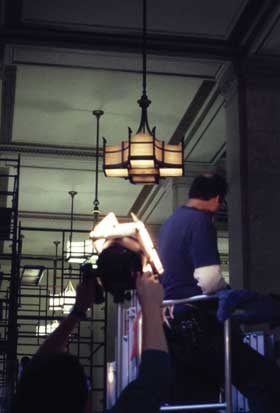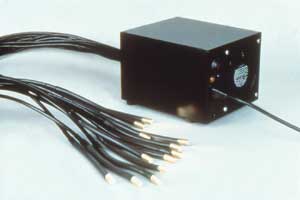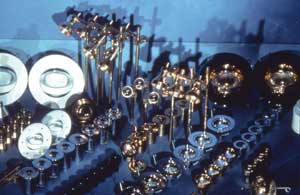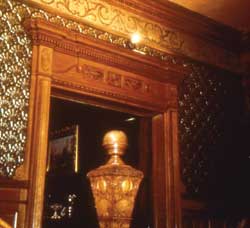Glass fiber optics, custom LEDs and organic LEDs are at the forefront of imaginative choices for affordable, sustainable, satisfactory, safe and energy-efficient lighting.
Gersil N. Kay, IESNA, Conservation Lighting International Ltd.
To expedite their research, scientists and engineers must use every
resource possible. Good instruments are essential, of course, but so is the lighting
for seeing the task at hand and getting the job done.
Contrary to popular opinion, lighting design is not a do-it-yourself
job. As with brain surgery, it requires a professional: Between reading instructions
and slicing, you could die of a misprint, to paraphrase Mark Twain. In the mercurial
domain of lighting, so many variables exist that only those who are knowledgeable
about its properties and performance can tame it. Special effects such as color,
motion and dimming are possible with just push-button control, but the designer
must be properly trained to execute this.

Color temperature makes a difference: Incandescent 2700 K color is seen in front, and
metal halide 4100 K color is seen in back. Images courtesy of Gersil N. Kay, Conservation
Lighting International Ltd.
The long history of the lighting field is complex and continues
to evolve. The original “green” construction methods for providing effective
lighting and ventilation have progressed from thousands of years of trial and error.
A similar experimental approach to developing artificial illumination continues
today as researchers worldwide develop lighting that is affordable, sustainable,
satisfactory, safe and energy-efficient.
In the lighting field, one size or type does not fit all. Only
if all the most energy-efficient lighting techniques best suited to the particular
application are known can affordable, sustainable and sophisticated illumination
be created within the guidelines of increasingly stringent energy conservation regulations.
Negotiating the lighting business also means having a thorough
understanding of what you are purchasing. Obviously, manufacturers do everything
possible to sell their wares. Sometimes, however, eagerness to sell goods creates
advertising that is overly fanciful and neglects to mention key properties. This
hinders the buyer’s ability to make the wisest decisions about which equipment
and techniques to use. Truth in advertising would benefit everyone.
Another key to successful lighting design is abiding by the building
codes and standards while still focusing on design and aesthetics. These codes and
standards represent only the barest minimum of requirements. Design is not considered
at all. Also related to codes and standards is the matter of recognizing the difference
between older materials and methods – prior to 1940 – and those employed
today. Failure to use imagination and common sense can waste money, effort and usable
materials and can yield results that are disappointing: Envision destroying a beautiful
marble staircase that has been safe for 125 years and replacing it with open slats
that provide neither the beauty nor the privacy and protection of the original.
Aesthetics and appropriateness also play a role in the lighting field.
For lighting designers in the US to catch up to those overseas,
we must adopt methods that have long been used successfully; we are at least 10
years behind our foreign colleagues and eventually end up buying their inventions.
The reasons for this situation include a lack of practical lighting education, terminal
inertia in changing procedures, and the sometimes still-insufficient information
available on compact fluorescent lightbulbs and LEDs, despite massive quantities
of it (Both technologies are highly innovative but are not there yet).

A glass fiber optics projector containing a metal halide lamp, small fan and optics. The lightguides were designed to simply be inserted into the 30-mm boss of the projector, which arrives factory assembled, so there is no labor.
Three types of imaginative lighting are already in use overseas:
glass fiber optics (GFO) for functional, as opposed to decorative, lighting; custom
LEDs; and, soon, organic LEDs. Each product serves a different purpose and can be
carefully combined with another or used separately. New developments appear almost
daily. Here are some examples:
1. Functional GFO has been around the longest; the first patent
for GFO was issued in 1882, but this method is still the most energy-efficient.
Based on the principle of total internal reflection, GFO is not identical to the
fiber optics used for communications; they are not interchangeable. Cool, reusable
GFO is miniaturized, so it can be retrofitted into most existing lighting fixtures.
It is the most sustainable because, with normal use, only a few lamps will need
relamping as often as 6000 hours (about a year and a half). Substantial savings
in installation, maintenance and operation lead to prompt payback on initial investment,
plus continued savings thereafter for the long life of this completely different
source/system.

Many custom and stock fittings can be manually screwed onto threaded
metal ferrules for easy replacement and secure focus.
2. Custom LEDs can be retrofitted to existing fixtures/spaces
or unique applications. They are made to dissipate the heat generated by the driver.
Because of the size of the components needed to dissipate heat, current LEDs cannot
be retrofitted easily into existing fixtures. Caveats: Additional air conditioning
is always required. LEDs are vulnerable to moisture, temperature, voltage change
and vibration. After 25,000 hours (five years), LED light levels could decrease
to less than 70 percent of initial output, which may be less than is needed. Then
the entire expensive system may have to be replaced. Individually replaced units
may be very conspicuous next to older ones. The color white is still under development,
and current versions can change color unexpectedly, defeating their purpose for
research. LED light levels are not yet as high as conventional lamp light levels.

Lighting design can be crucial
to safety: A glaring LED light near the bottom of a stair can cause an accident
if the person descending is blinded by the bright light.
3. Organic LEDs are the latest development. They are manufactured
in a simple printing process. This is different from original LEDs, which contain
many components from different sources with varied quality (as do automobiles).
Organic LEDs can be inserted into architectural surfaces, furniture, glass (to be
translucent or transparent) and even into fabrics. The only drawback for wireless
use is that lengthy operation requires a long-lasting lightweight battery.
New types of lighting careers have emerged, and each specialist
can be instrumental in a variety of projects. One option is commissioning, as is
done for heating, ventilation and air conditioning. Another approach is following
a project from concept and design to installation, maintenance, operation and final
disposal. A third is the building information model, in which a lighting design
specialist traces the project from the very beginning and furnishes 3-D drawings
of what was actually installed, and where. This is invaluable for future maintenance
and repair. Indeed, scheduled maintenance might be replaced by predictable maintenance,
where the manager could forecast which items are about to fail and could institute
early steps to avoid costly shutdowns or loss of experiments.
Meet the author
Gersil N. Kay, IESNA, is president of Conservation Lighting International
Ltd. in Philadelphia; e-mail: [email protected].